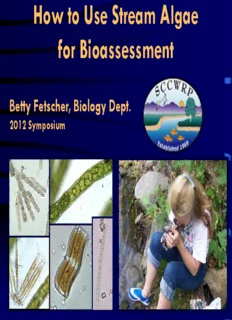
How to Use Stream Algae for Bioassessment PDF
Preview How to Use Stream Algae for Bioassessment
How to Use Stream Algae for Bioassessment Betty Fetscher, Biology Dept. 2012 Symposium 1 Goals of Session California is moving forward with incorporating algae into monitoring programs… What’s involved? • Walk through steps of stream bioassessment using algae • Introduce users to tools that are available, or under development, to support algae-based bioassessment • Foster an open forum for discussion about the process and tools 2 Session Outline • Field sampling of stream algae • Laboratory analyses • Data processing, analysis, & interpretation • User-support resources 3 Why add Algae to the State’s Bioassessment Toolkit? • Weight of evidence • Provides complementary information to bugs in terms of different • stressors • time frames • ranges of response Applications of Algae Data stream condition/water quality Taxonomic composition ambient assessment (“quality”) compliance monitoring bio-objectives Biomass (“quantity”) algal nuisance/eutrophication – algal cover ambient assessment – chlorophyll a – ash-free dry mass compliance monitoring – algal biovolume NNE framework How do we sample stream algae for community composition and biomass? 66 SWAMP Algae Sampling Protocol • Designed to fit well into existing field bioassessment SWAMP practices (bugs, Algae PHab) Field SOP • Modular June 2009 (updated construction May 2010) sccwrp.org Technical Report #602 7 We Look at two Algal Assemblages soft-bodied algae (& cyanobacteria) diatoms Reachwide Benthos Sampling • as with bugs… multiple habitat types, as opposed to targeted substrata (cobbles) • diatoms and soft algae are co-collected within a single sampling effort 99 Algae Sampling Co-occurs with Bug Sampling 10
Description: